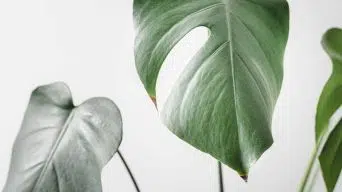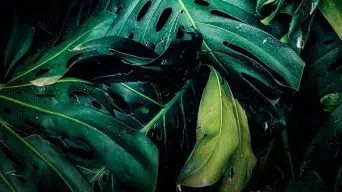The Monstera plant is a tropical perennial that has large and showy leaves.
The Monstera, also known as the Swiss cheese plant, can be grown in most climates if given the proper care.
One common issue that Monstera owners face is curling leaves.
This can be caused by several different factors, including underwatering, temperature stress, and pest infestation, among others.
By understanding the causes of curling leaves, you can take the necessary steps to fix the problem and keep your Monstera plant healthy.
Causes of Curling Monstera Leaves And How To Fix Them
Houseplants are a wonderful way to introduce vitality and beauty into your home. However, it’s crucial to care for them appropriately to avoid common issues.
Monstera leaf curling is a prevalent concern for many houseplant owners, and it can indeed be a frustrating problem to tackle. The encouraging news is that there are straightforward steps you can follow to prevent and address this issue.
Here, we outline the primary causes of Monstera leaves curling and provide effective solutions to remedy the problem.
1. Underwatering
One of the most common problems indoor gardeners face with Monsteras is curling leaves.
This problem is most often caused by underwatering, which can cause the leaves to lose moisture and become crispy.
When monstera plants don’t receive enough water, their leaves will start to wilt and curl to prevent further water loss.
There are a few reasons why this happens.
First, Monsteras are native to tropical climates, where they receive a lot of rainfall.
As such, they are accustomed to high humidity levels and need a lot of water to thrive.
Second, their leaves are large and have a high surface area, meaning they lose moisture quickly.
To prevent leaves from curling, it is essential to water your plants regularly and deeply. Water only when the top inch of soil is dry to the touch.
In general, Monsteras should be watered about once a week, but this may vary depending on the climate and the size of the plant.
How To Fix It
If your Monstera is showing signs of underwatering, the best course of action is to water it deeply and allow the soil to dry out completely before watering again.
Monstera plants need a lot of water, so make sure to water yours deeply and regularly to prevent the leaves from curling.
Creating a watering schedule is an important part of caring for your plants, as it helps you ensure that they are getting the right amount of water at the right time.
It is also good to increase the humidity around your Monstera by placing it on a pebble tray or using a humidifier.
2. Overwatering
When a Monstera is overwatered, the roots are susceptible to rotting, which in turn will cause the leaves to start curling.
The lack of oxygen in the soil prevents the plant from taking up the necessary water and nutrients it needs to survive, causing the leaves to start curling as it struggles to obtain the oxygen it needs to continue growing.
A Monstera that has been overwatered will have soggy, brown, or yellow leaves that are wilting.
The leaves may also fall off easily, and the stem may start to rot.
To prevent overwatering, make sure to water your Monstera only when the top inch of soil is dry to the touch.
Using well-draining potting soil and water with distilled or filtered water is also good.
How To Fix It
If your Monstera is displaying signs of overwatering, the best course of action is to stop watering immediately and allow the soil to dry out thoroughly.
Subsequently, resume watering only when the top inch of soil is dry to the touch.
Monstera plants require deep watering, but it should only be administered when the soil has dried sufficiently.
Using a moisture meter proves to be an effective method for determining the appropriate time to water your Monstera plant. It allows you to gauge the moisture level in the soil and ensures watering occurs only when the soil is dry to the touch.
If you suspect your plant has been overwatered, it is advisable to repot it using fresh, well-draining potting soil. When repotting, be sure to select a pot with drainage holes at the bottom, facilitating excess water drainage and preventing root rot.
To enhance drainage and soil aeration, consider adding a small amount of perlite to the potting soil before planting. Perlite, being a lightweight, porous material, helps retain moisture while enabling excess water to drain away, thus mitigating the risk of root rot.
3. Temperature Stress
The Monstera plant is native to tropical regions and prefers warm, humid conditions. They thrive in temperatures between 60-80 degrees Fahrenheit.
When the Monstera is exposed to cold temperatures, the leaves will curl to protect the plant from the cold air.
Leaf curling is a defense mechanism that prevents the plant from losing moisture and exposure to drafts.
When exposed to consistently high temperatures, Monstera leaves curl to prevent water loss through transpiration, the process by which plants release water vapor from their leaves in order to cool themselves and maintain a healthy water balance.
Curling also helps reduce the surface area exposed to direct sunlight, further protecting the plant from heat stress.
How To Fix It
If your Monstera is curling due to temperature stress, the best course of action is to move it to an ideal location for its growth.
Monstera plants prefer warm, humid conditions and should be kept in 60-80 degrees Fahrenheit temperatures.
When temperatures drop, protect your plant from drafts by moving it away from windows and doors.
If you have the opportunity to place your Monstera outdoors, make sure to choose a spot with bright indirect light and out of direct sunlight to prevent heat stress, as direct sunlight can be too intense for this tropical plant.
4. Low Humidity
Low humidity is one of the most common reasons Monstera leaves may start to curl.
When the air is too dry, the plant can’t get enough moisture from the atmosphere and starts to draw water out of its leaves.
This causes the leaves to shrink and eventually start to curl up at the edges.
Maintaining a healthy humidity level is essential for Monstera plants to thrive, as too little humidity can cause the leaves to become dry and brittle and can even lead to the plant’s death if left unchecked.
How To Fix It
If your Monstera leaf curls due to low humidity, the best course of action is to increase the humidity around the plant.
This can be done by placing the pot on a pebble tray, using a humidifier, or misting the plant with water.
You should also make sure that your Monstera is not placed in direct sun, as this can further dry out the air around the plant.
5. Pest Infestation
Pests are another common cause of Monstera leaf curl.
Mealybugs, aphids, spider mites, and scale insects are all common pests that can infest Monstera plants and cause the leaves to curl.
These bugs feed on the plant’s sap, causing Monstera leaves to turn yellow or brown and eventually start to curl.
An insect infestation can also cause the plant to become stunted and produce fewer leaves.
How To Fix It
If your Monstera is infested with pests, the best course of action is to treat the plant with insecticidal soap or neem oil.
You can also try to remove the pests by hand using a cotton swab dipped in rubbing alcohol.
Check your Monstera regularly for signs of pests and take action as soon as you see them.
6. Fungal Infection
Fungal infections are another common reason for curling Monstera leaves.
If you notice spots on the leaves of your Monstera plant, it could be a sign of a fungal infection, such as powdery mildew or leaf spot, which can cause the leaves to start curling if left untreated.
Fungal infections are caused by microscopic fungi that invade plant tissue and feed on the host plant’s cells.
This feeding damages plant tissue, causing it to die and ultimately leading to curling or distorting leaves.
While there are several ways to prevent or treat fungal infections, the best way to avoid them is to water your monstera plants from below, using a drip system or a watering can with a long spout.
This will help keep the leaves dry, which will help prevent fungal infections from taking hold.
How To Fix It
If your Monstera is already infected with a fungus, you can treat it with a fungicide.
There are many different types of fungicides available, so be sure to read the label carefully and choose one specifically designed for use on Monstera plants.
If you notice yellowing leaves on your Monstera plant, it is important to take action quickly to prevent the spread of fungus by removing any infected leaves and disposing of them properly.
You should also water your Monstera from below to help prevent future infections.
7. Soil Issues
Soil that is too dense or too dry can cause Monstera leaves to curl.
If the soil is too dense, it can restrict the plant’s roots and prevent them from getting the water and nutrients they need. This will cause the leaves to turn yellow or brown and eventually start to curl.
If the soil is too dry, the plant will start to draw water out of its leaves in an attempt to compensate, also causing curled leaves.
How To Fix It
You will need to amend the soil with some organic matter, such as peat moss or compost to fix this issue.
This will help to loosen the soil and make it more porous, allowing the roots to access water and nutrients better.
You should also repot your Monstera every two to three years to ensure the plant has fresh, nutrient-rich soil.
8. The Plant is Root-Bound
Monstera leaves tend to curl when they are root-bound.
Root bound means that the plant’s roots have become so tightly packed that they can no longer properly absorb water and nutrients from the soil.
A root-bound Monstera can happen if the pot is too small or if the plant is not getting enough water.
When the roots are unable to absorb moisture, the leaves will start to curl as a way to conserve water.
How To Fix It
To fix this issue, carefully remove the plant from its pot and check the roots. If they are wrapped tightly around the bottom of the pot, it is time to repot in a larger container with fresh soil.
When removing the plant from its pot, check for any black or mushy roots. This is a sign of root rot, which must be treated before the plant can be repotted.
Be careful not to damage any healthy roots while you are repotting.
Damaged roots will not be able to properly absorb water and nutrients, which will cause the leaves to curl.
9. Overfertilization
When the plant receives too much fertilizer, the nutrients can build up in the soil and cause the leaves to become distorted.
In some cases, Monstera leaves may even turn brown and fall off.
In addition to causing curled Monstera leaves, overfertilization can also stunt the growth of Monstera plants and make them more susceptible to disease.
As a result, it is essential to fertilize Monstera plants only when necessary and use a light hand when applying fertilizer.
How To Fix It
The best way to fix this issue is to flush the soil with water.
This will help to remove any excess fertilizer from the soil and prevent it from causing further damage to the plant.
After flushing the soil, only fertilize when they are actively growing (usually in the spring and summer).
Avoid fertilizing Monstera plants during the fall and winter. They are dormant during this time and do not need additional nutrients.
10. Tap Water
Tap water often contains high chlorine levels and other chemicals that can be harmful to Monstera plants.
Over time, these chemicals can build up in the soil and cause the leaves to become distorted.
In some cases, the leaves may even turn brown and fall off.
It is essential to use filtered or distilled water when watering Monstera plants to prevent this from happening.
How To Fix It
If the leaves on your Monstera plant are already curled, you can try to reverse the damage by switching to filtered or distilled water.
Water the plant with filtered or distilled water for a few weeks and see if the leaves start to uncurl.
If the leaves do not improve, you may need to repot the plant in fresh soil.
11. Natural Leaf Curl
Monstera leaves are naturally curved, which is not a cause for concern.
The leaves of Monstera adansonii, for example, are deeply lobed and have natural curls.
Monstera deliciosa leaves are also known to curl when they are young.
As the leaves mature, they will uncurl and become more flattened.
A Monstera’s new leaf will generally be more curled than older leaves.
This is normal and not a cause for concern.
How Long Does It Take for a Monstera Leaf to Uncurl?
A Monstera leaf typically takes about two weeks to uncurl.
However, this can vary depending on the size of the leaf, the type of Monstera plant, and the growing conditions.
Leaves can also take longer to uncurl if they are damaged or if the plant is under stress.
So, if you see a Monstera leaf starting to curl, don’t worry!
Give it some time, and it will uncurl on its own.
How To Prevent Monstera Leaf Curling
The best way to prevent Monstera leaf curling is to ensure that the plant is provided with the appropriate growing conditions.
Monstera plants thrive in warm, humid environments with bright, indirect sunlight. It’s crucial to use well-draining soil that is rich in organic matter.
To further discourage leaf curling, make sure to water the plant regularly and fertilize it during the growing season. Plants are sensitive to changes in their environment, so if you need to move the plant, do so gradually to allow it time to adjust.
Monstera plant leaves may also curl if the plant is pot-bound. Therefore, it’s essential to repot your plant every one to two years to prevent this from happening.
Monsteras are resilient plants that can tolerate a wide range of conditions. However, they are still susceptible to leaf curling if their environment is not ideal. By providing the plant with proper care, you can prevent Monstera leaves from curling and ensure your plant remains healthy and happy.
Final Thoughts
Leaf curling is a prevalent issue among Monstera plants and can be attributed to various factors.
The most effective solution to this problem is to ensure meticulous environmental management, providing appropriate levels of water and humidity.
Additionally, monitoring the surroundings for potential stressors that might adversely affect the plants is crucial.
Monsteras demonstrate resilience and can typically recover from leaf curling with some additional tender loving care.
Make sure to closely observe your indoor plant and modify its care regimen accordingly.
With patience and attentiveness, your Monstera will regain its health and exhibit lush growth in no time!







